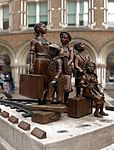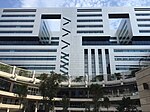Liverpool Street bus station
Bus stations in LondonLondon transport stubsPages with no open date in Infobox stationTransport in the City of LondonUse British English from January 2017

Liverpool Street bus station is located within Liverpool Street station and is next to the Broadgate shopping and office complex. It has been closed since 2017 until September 2019 to allow construction work on the adjacent Broadgate site redevelopment.
Excerpt from the Wikipedia article Liverpool Street bus station (License: CC BY-SA 3.0, Authors, Images).Liverpool Street bus station
Sun Street Passage, City of London
Geographical coordinates (GPS) Address Nearby Places Show on map
Geographical coordinates (GPS)
| Latitude | Longitude |
|---|---|
| N 51.518333333333 ° | E -0.0825 ° |
Address
Sun Street Passage
Sun Street Passage
EC2M 2AU City of London
England, United Kingdom
Open on Google Maps











